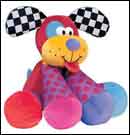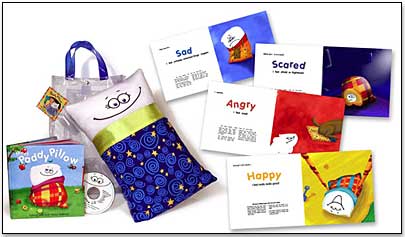 |
Plush Toys Enhance Child Development
By Michaele Birney Arneson, with contributions by
Heather Augustyn
November 1, 2002
Toys
that help children learn about and interact with their environment
play an important role in successful social and emotional development.
For instance, sensory skills (vision, hearing, touch, taste, smell)
develop more quickly during the first two years of a child’s
life than at any other point. For that reason, infant toys that
maximize sensory stimulation are not only entertaining for children,
but also aid in their successful development.
 Puppy
Tunes®
Puppy
Tunes® |
Some
plush toys, like those developed by Lamaze®
and marketed by Learning Curve International, Inc.,
are designed to encourage multiple areas of sensory development.
For example, Puppy Tunes® allows the child
to hear a different tone by squeezing each of the puppies four brightly
patterned legs, each with a different color paw.
 Eden®
Lamb
Eden®
Lamb |
Maureen
Arseneau, a brand manager for Learning Curve’s Eden®
line, says there are “two worlds for an infant: stimulating
and soothing.” Learning Curve developed two brands to cater
to these needs. Lamaze stimulates with lights, music, and a variety
of different textures. Eden’s lines are more soothing and
nursery friendly, designed to calm the child and make him feel safe.
Arseneau explains that the soothing aspect of a child’s life
is often overlooked by toy companies, but “soothing is an
important part of a child’s life.”
Imaginary
Worlds
As
children approach the age of two or three, they begin to play imaginatively,
a skill that, according to Jerome L. Singer, Ph.D. and professor
of psychology at Yale University, “becomes the foundation
for the inner resources of imagination that every adult requires.”
Plush
toys in the form of animals, or other objects children easily relate
to, are used by children at this stage as they learn to interact
with their environment via their ‘created worlds.’ And
since children of this age enjoy tactile stimulation, products like
Folkmanis® puppets that combine a plush texture
with the functionality of a puppet especially engage the imagination.
Putting
It Into Words
Plush
toys can also be used to encourage or enhance how children express
themselves and communicate with others. After volunteering at a
crisis help line and realizing that even she sometimes had difficulty
communicating with others, Aimee Markelz, founder and president
of Talk Inc., looked for ways she could help facilitate
this process with children.
 Paddy Pillow
Paddy Pillow |
With
the input of psychologists, speech therapists, and social workers,
Markelz created the plush toy Paddy Pillow to help parents and children
explore the world of emotions together. Paddy Pillow,
a soft little pillow who has a hard time naming and explaining how
he feels, is used with accompanying books and songs to help children
identify and relate to emotions such as happy, sad, love, scared,
angry, shy, ashamed, and proud.
“Children
relate to the physical object, and when a book or video is used
with a plush character, they seem to catch on more easily,”
said Markelz. “I have heard from parents, teachers, and social
workers who share stories about a child’s attachment to Paddy
and the new emotional vocabulary that child has.”
RELATED
LINKS:
 Retailer's Viewpoint: Retailers
Weigh In On Plush
Retailer's Viewpoint: Retailers
Weigh In On Plush
 Product Summary:
Plush That's Good Enough to Eat
Product Summary:
Plush That's Good Enough to Eat
 Past Present: A Century of
Plush
Past Present: A Century of
Plush
 Side Bar: Where Bears Are
Born
Side Bar: Where Bears Are
Born
Want to see more Plush Toys? Click
Here...
Return to ToyDirectory Monthly front page: Click
Here
Send comments about this article to: emailtoydirectory@gmail.com
|
 |
